主办 : 南京艺术学院美术馆
Host: Art Museum of Nanjing University of the Arts
协办 : 大未来林舍画廊
Co-organizer: LIN LIN Gallery
前言
冷门绝学
The Art of a Niche
当代绘画跟“冷门”与“绝学”好像没有丁点儿关系。这个专有的名词,冷门到常常只出现在研究性机构的红头文件里,去鼓励更多的学者在冷门学科中找到自己的位置,并有所成就。我也不知道绘画在这个时代能取得什么样的成就。有人说绘画死了,有人说绘画即将被替代,有人说绘画在艺术媒介爆炸的时代就是表达的局限。艺术开始被划分阶层,想象力也被划分了阶层,还有可怜的展览政治。第60届威尼斯双年展,绘画好像以“少数裔”的角色又重新回归到双年展的舞台,证明的却是“全球南方”的正确。绘画看似占领了整个威双的花园展区,又恰恰证明了自己才是双年展的外人(第60届威尼斯双年展的主展命题为“处处都是外人”)。绘画正与时代及个人进行着一段貌合神离的假性亲密关系,我们怀着一种跟绘画无关的目的去绘画,绘画成为了一项需要结“尾款”的工程,成为一个只需说服别人无需说服自己的故事,成为了诗歌、哲学、新闻的漂亮图注,或是一次不需要深度思考的脑筋急转弯和拼图游戏。
Contemporary painting seems to bear no connection to the so-called “obscure” or “esoteric” studies. These specialized terms are so niche they only surface in official documents from research institutions, meant to encourage scholars to carve out their own place in underexplored disciplines. But what can painting still achieve in today’s world? Some say painting is dead; others claim it’s on the brink of being replaced, or that in an era of limitless artistic media, painting has become a constraint on expression. Art itself has been hierarchized, imagination stratified, and exhibition politics reduced to a pitiful game. At the 60th Venice Biennale, painting returned to the stage, though in the role of a “minority,” only to affirm the so-called righteousness of the “Global South.” It filled the Biennale’s garden spaces, yet this very dominance underscored its status as an outsider (echoing the main theme of the Biennale, “Strangers Everywhere”). Painting today engages in a hollow, pseudo-intimacy with both the era and the individual. We approach painting with purposes disconnected from the act itself; it has become a project awaiting its “balance payment”, a narrative crafted to persuade others but not ourselves. It’s turned into a decorative illustration for poetry, philosophy, and journalism, or a shallow brainteaser or puzzle that requires no real depth of thought.
我们便是要在这样一种语境下去谈申亮的绘画,或者去谈申亮的绘画处境。回到成功学意义上的成功绘画,第一需要画家的身份,第二需要难度适中的观念,第三需要一种可被定义为成功的参照(市场和位置)。如果这三者在申亮身上都无法获得精准的对应,那画家所怀揣的冷门绝学到底是什么?——申亮在用手绘画!这看上去是句废话,因为绘画的人几乎都在用手绘画,但好像又没有。手是身体的延伸,是靠身体性落在各种材料上,这是很简单的道理,但很多流行的绘画恰恰缺的就是身体性。用身体去对抗图像与文本,对抗的既是当下绘画的特征,同样也是当下绘画的毛病。
In this context, we focus on Shen Liang’s painting or his work’s unique position. By today’s standards of artistic success, three key elements are often required: first, the artist’s identity; second, a concept that strikes the right balance between depth and accessibility; and third, a measurable benchmark for success—whether through the market or status. If Shen Liang doesn’t align neatly with any of these criteria, then what is the “niche mastery” this painter holds? Shen Liang paints by hand! This may sound like an obvious statement—most painters use their hands—but not quite. The hand, as an extension of the body, connects physically with the material, a simple truth often missing from much of today's popular painting. What’s lacking in so much contemporary art is this very sense of the body. Shen Liang brings the body back into painting, using the physical act to resist the dominance of image and text, confronting not only the prevailing characteristics of contemporary painting but also its underlying flaws.
在信息社会之中,看见、找到、获取变得更加容易,绘画在这样的背景下看似能开辟了一条条的小道,却又在大数据与核心艺术资源的双重规训下回到了一条主干道上。所谓的风格在路上撞了车,观念在路上撞了车,阐释也在路上撞了车。甭管新手或是老手,在有目的地的高速公路上,终究逃不过拥堵的命运。“拥堵”则成为了当代绘画最重要的景观,大家为了一个目的地,而不是沿途的风景。“慢吞吞”的申亮没有挤在这条高速路上,因为看不见他绘画中明确的目的地。申亮不是依靠绘画去“到达”,更不是迎合资源的一种有序状态。漫无目的的创作,漫无目的的生活。就像初学绘画,且拥有画笔的孩童,只是因为“手痒”而不停地涂抹。不分材料,不分对象,不分媒介与载体。矛盾与暧昧在申亮那里都有,颜色上的,笔触上的,情绪上的。哪怕只有一个人存在的画面,似乎也能感觉到一种即将来临的冲突,或者一次猝不及防的笑场。面对一本正经的创作,申亮的绘画有着一种独特的“慵懒”,就这么自然而然的流淌出来。如果慵懒也是一门绝学,申亮的内功心法有三,其一是在历代老物件中习得“随形而作”;其二是从传统书画中习得“宁拙毋巧”;其三是在刷屏时代中习得“半秒真实”。三种状态在内部不停地对抗与和解构成了申亮作品中的“慵懒”。
In the information age, it has become effortless to see, discover and acquire. Painting, in this context, seems to open up new paths, yet under the dual pressures of big data and the mainstream art world, it always loops back to the same well-trodden road. Along the way, styles clash, ideas collide, and interpretations falter. Whether you’re a newcomer or a veteran, it’s inevitable to rally on a crowded highway of purpose. In fact, “congestion” has become the defining landscape of contemporary painting—everyone is racing toward a destination, rather than savoring the scenery along the way. Shen Liang, however, doesn’t join this race. He doesn’t paint with a clear goal in mind, nor does he follow the orderly rhythms of resources within the art world. His approach to painting, like his approach to life, is without direction—more like a child with a paintbrush, scribbling simply because of an itch to create. He doesn’t distinguish between materials, subjects, or mediums. His work is full of contradictions and ambiguities—whether in color, brushstroke, or emotion. Even in a canvas with just one figure, you can sense a brewing tension, or perhaps an unexpected burst of laughter. Compared to the serious traditional creation, Shen Liang’s work flows with a certain “laziness,” an effortless, natural rhythm. If laziness were an art form, Shen would be a master. His work is shaped by three guiding principles: first, from ancient artifacts, he learned the art of “creating in harmony with form.” Second, from traditional painting and calligraphy, he embraced the philosophy of “better crude than clever.” And third, in today’s screen-saturated world, he has captured the essence of “half-second authenticity.” These three principles, in constant tension and reconciliation, form the signature “laziness” that defines Shen Liang’s art.
在俗世间中看花花世界,这是我认识的申亮,在花世界中冷眼旁观,这是我认识的作品。申亮有手,眼中有光,对于一个画家,这也就够了。
In the dazzling spectacle of this world, Shen Liang observes with a cool detachment—that’s how I know him and his art. Shen Liang fully embraces the creativity of his hands and treasures the light in his eyes; for a painter, that is all one needs.
林书传
2024.10.2
Lin Shuchuan
October 2, 2024
部分作品图
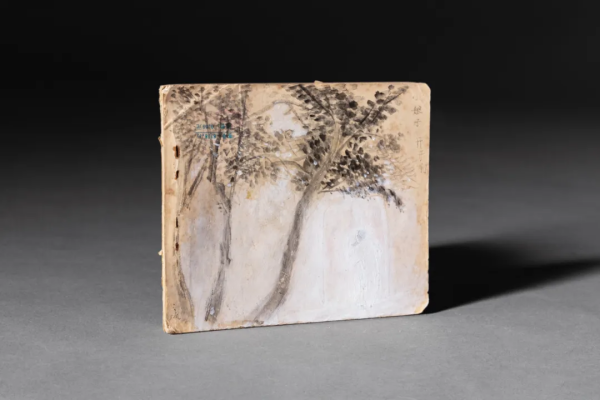
《画书》娘子开开门 9.5x12.5x1cm 旧书 丙烯 2015
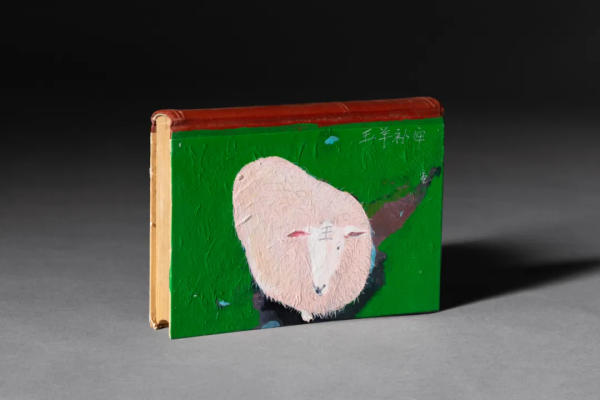
《画书》王羊补牢 15x20.7x3.5cm 旧书 丙烯 2024
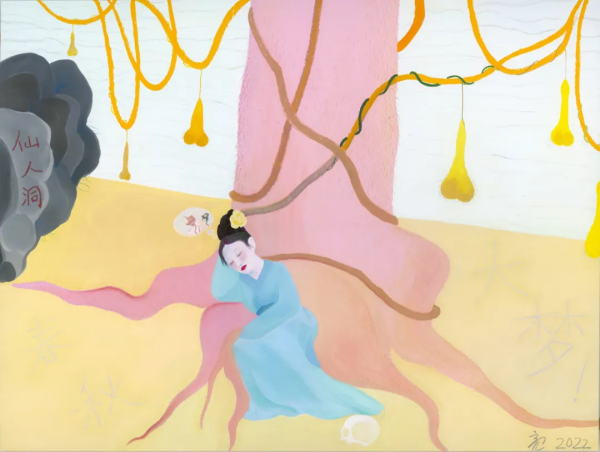
仙人洞 210 x 279cm 布面丙烯 2022
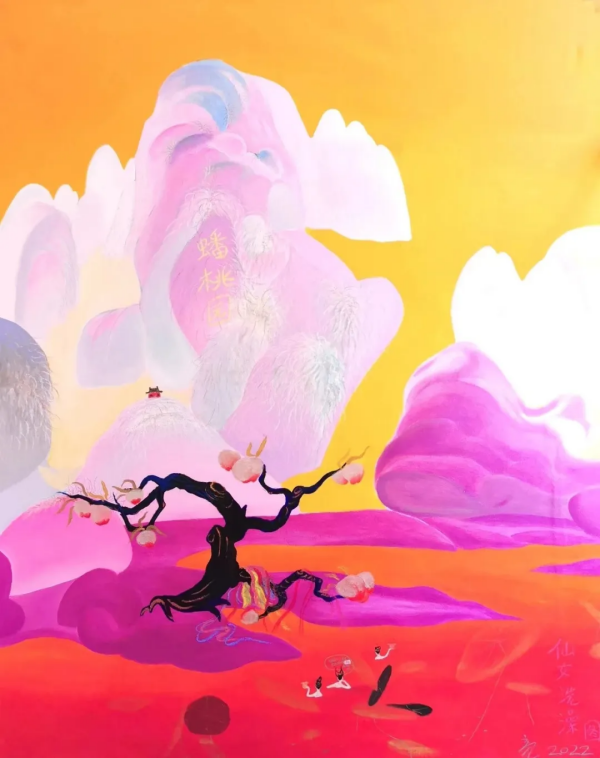
蟠桃园 267 x 210cm 布面丙烯 2022
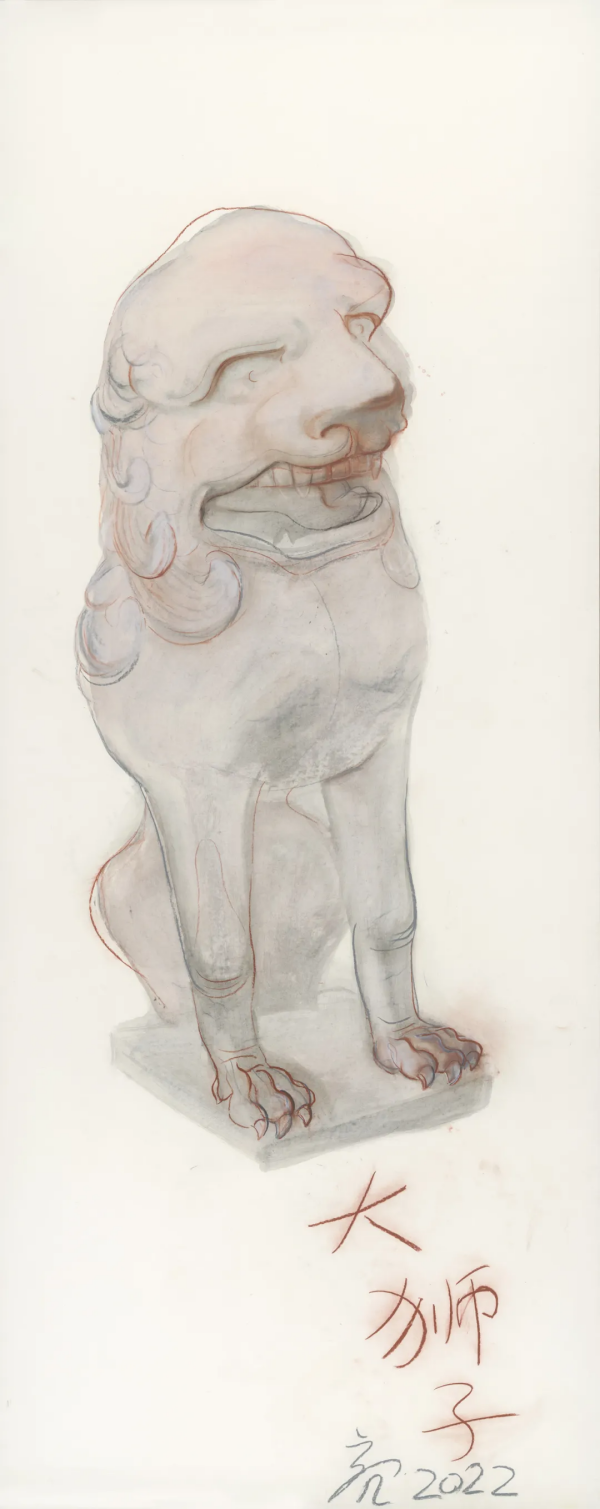
大狮子 350 x 140cm 纸本 水彩 石墨 2022
艺术家简介

申亮
1976年出生于中国辽宁,2003年毕业于中央美术学院油画系获硕士学位,现生活工作于北京。部分个展:2024年,神仙回收处,拾萬空间,北京; 2021年,心跳草,当代唐人艺术中心,曼谷,泰国; 2021年,毛嗑,大未来林舍画廊, 台北; 2021年,申亮个人项目,香港巴塞尔,香港; 2019年,申亮·大画西游,独立项目,西岸艺术与设计博览会,上海;2017年,山水也霓虹,大未来林舍画廊,台北;2015年,申亮,大未来林舍画廊,台北;2013年,长物志 申亮个展,蜂巢当代艺术中心,北京;2012年,三年二班,半岛维画廊,香港;2012年,橱窗,鼎峰空间,北京;物·拓·图,空间站,北京;2011年,远·山,秀瓷画廊,北京;2008年,练习薄,Michael Schultz 画廊,德国柏林;2008年,This is a book,今日美术馆,北京;2008年,Hope to see you there,Michael Schultz 画廊,韩国首尔